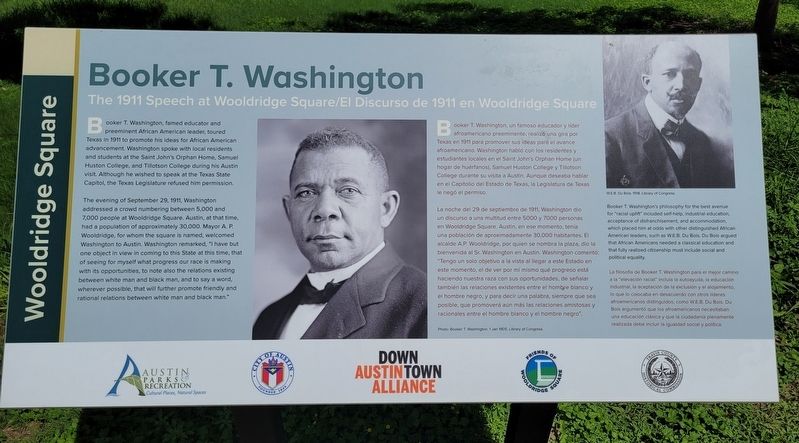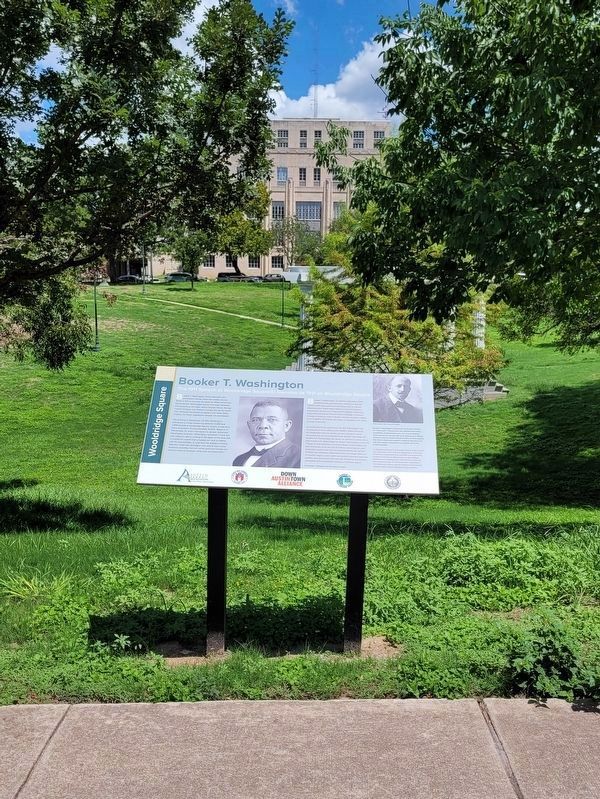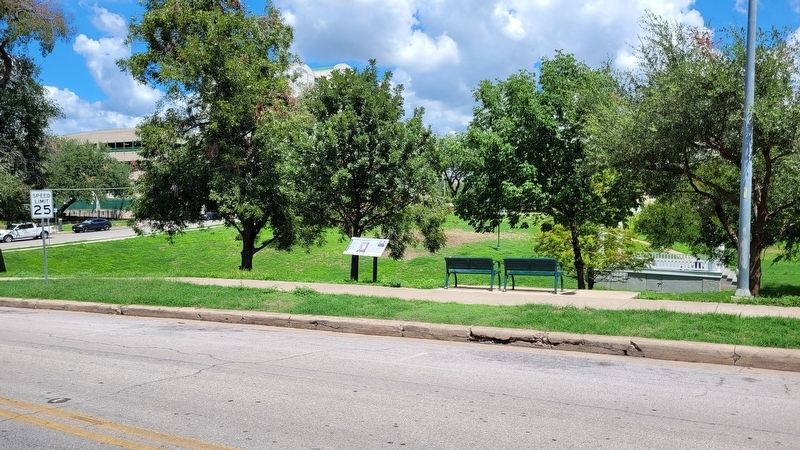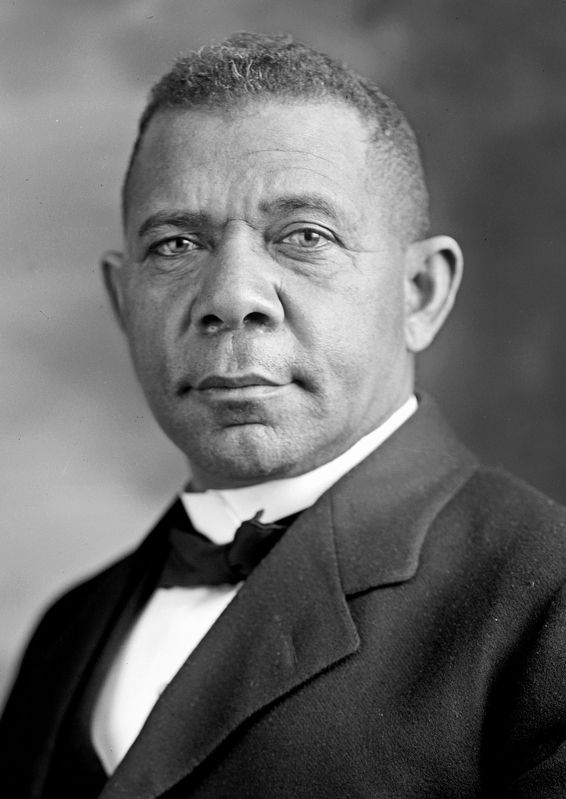Downtown Austin in Travis County, Texas — The American South (West South Central)
Booker T. Washington
Wooldridge Square
The 1911 Speech at Wooldridge Square
Booker T. Washington, famed educator and preeminent African American leader, toured Texas in 1911 to promote his ideas for African American advancement. Washington spoke with local residents and students at the Saint John's Orphan Home, Samuel Huston College, and Tillotson College during his Austin. visit. Although he wished to speak at the Texas State Capitol, the Texas Legislature refused him permission.
The evening of September 29, 1911, Washington addressed a crowd numbering between 5,000 and 7,000 people at Wooldridge Square. Austin, at that time, had a population of approximately 30,000. Mayor A. P. Wooldridge, for whom the square is named, welcomed Washington to Austin. Washington remarked, "I have but one object in view in coming to this State at this time, that of seeing for myself what progress our race is making with its opportunities, to note also the relations existing between white man and black man, and to say a word, wherever possible, that will further promote friendly and rational relations between white man and black man."
Booker T. Washington's philosophy for the best avenue for "racial uplift" included self-help, industrial education, acceptance of disfranchisement, and accommodation, which placed him at odds with other distinguished African American leaders, such as W.E.B. Du Bois. Du Bois argued that African Americans needed a classical education and that fully realized citizenship must include social and political equality.
Captions
Lower Middle: Photo: Booker T. Washington. 1 Jan 1905. Library of Congress.
Upper Right: WEB Du Bois, 1918, Library of Congress
Spanish
B ooker T. Washington, un famoso educador y lider afroamericano preeminente, realizó una gira por Texas en 1911 para promover sus ideas para el avance afroamericano. Washington habló con los residentes y estudiantes locales en el Saint John's Orphan Home (un hogar de huérfanos), Samuel Huston College y Tillotson College durante su visita a Austin. Aunque deseaba hablar en el Capitolio del Estado de Texas, la Legislatura de Texas le negó el permiso.
La noche del 29 de septiembre de 1911, Washington dio un discurso a una multitud entre 5000 y 7000 personas en Wooldridge Square. Austin, en ese momento, tenía una población de aproximadamente 30,000 habitantes. El alcalde A.P. Wooldridge, por quien se nombra
la plaza, dio la bienvenida al Sr. Washington en Austin, Washington comentó: "Tengo un solo objetivo a la vista al llegar a este Estado en este momento, el de ver por mi mismo qué progreso está haciendo nuestra raza con sus oportunidades, de señalar también las relaciones existentes entre el hombre blanco y el hombre negro, y para decir una palabra, siempre que sea posible, que promoverá aún más las relaciones amistosas y racionales entre el hombre blanco y el hombre negro".
La filosofía de Booker T. Washington para el mejor camino a la "elevación racial" incluía la autoayuda, la educación Industrial, la aceptación de la exclusión y el alojamiento, lo que lo colocaba en desacuerdo con otros líderes afroamericanos distinguidos, como W.E.B. Du Bois. Du Bois argumentó que los afroamericanos necesitaban una educación clásica y que la ciudadanía plenamente realizada debe incluir la igualdad social y politica.
Erected by Austin Park & Recreation, City of Austin, Downtown Austin Alliance, Friends of Wooldridge Square and Travis County Historical Commission.
Topics. This historical marker is listed in these topic lists: African Americans • Civil Rights. A significant historical date for this entry is September 29, 1911.
Location. 30° 16.324′ N, 97° 44.744′ W. Marker is in Austin, Texas, in Travis County
. It is in Downtown Austin. Marker is at the intersection of West 9th Street and Guadalupe Street, on the left when traveling east on West 9th Street. The marker is located in the southern section of Wooldridge Square by the 9th Street sidewalk. Touch for map. Marker is at or near this postal address: 900 Guadalupe Street, Austin TX 78701, United States of America. Touch for directions.
Other nearby markers. At least 8 other markers are within walking distance of this marker. Wooldridge Square (here, next to this marker); Votes for Women (here, next to this marker); 1933 Austin Public Library (within shouting distance of this marker); Wooldridge Park (within shouting distance of this marker); Austin's Moonlight Towers (within shouting distance of this marker); Hirshfeld Cottage (about 300 feet away, measured in a direct line); Hirshfeld House (about 500 feet away); Ira Hobart Evans (about 500 feet away). Touch for a list and map of all markers in Austin.
Also see . . .
1. Booker T. Washington. Wikipedia
Booker Taliaferro Washington (April 5, 1856 – November 14, 1915) was an American educator, author, orator, and adviser to several presidents of the United States. Between 1890 and 1915, Washington was the dominant leader in the African-American community and of the contemporary black elite. Washington was from the last generation of black American leaders born into slavery and became the leading voice of the former slaves and their descendants. They were newly oppressed in the South by disenfranchisement and the Jim Crow discriminatory laws enacted in the post-Reconstruction Southern states in the late 19th and early 20th centuries.(Submitted on September 2, 2022, by James Hulse of Medina, Texas.)
2. W. E. B. Du Bois. Wikipedia
Earlier, Du Bois had risen to national prominence as a leader of the Niagara Movement, a group of African-American activists who wanted equal rights for blacks. Du Bois and his supporters opposed the Atlanta compromise, an agreement crafted by Booker T. Washington which provided that Southern blacks would work and submit to white political rule, while Southern whites guaranteed that blacks would receive basic educational and economic opportunities. Instead, Du Bois insisted on full civil rights and increased political representation, which he believed would be brought about by the African-American intellectual elite. He referred to this group as the Talented Tenth, a concept under the umbrella of racial uplift, and believed that African Americans needed the chances for advanced education to develop its leadership.(Submitted on September 2, 2022, by James Hulse of Medina, Texas.)
Credits. This page was last revised on May 31, 2023. It was originally submitted on September 2, 2022, by James Hulse of Medina, Texas. This page has been viewed 177 times since then and 49 times this year. Photos: 1, 2, 3, 4. submitted on September 2, 2022, by James Hulse of Medina, Texas.



